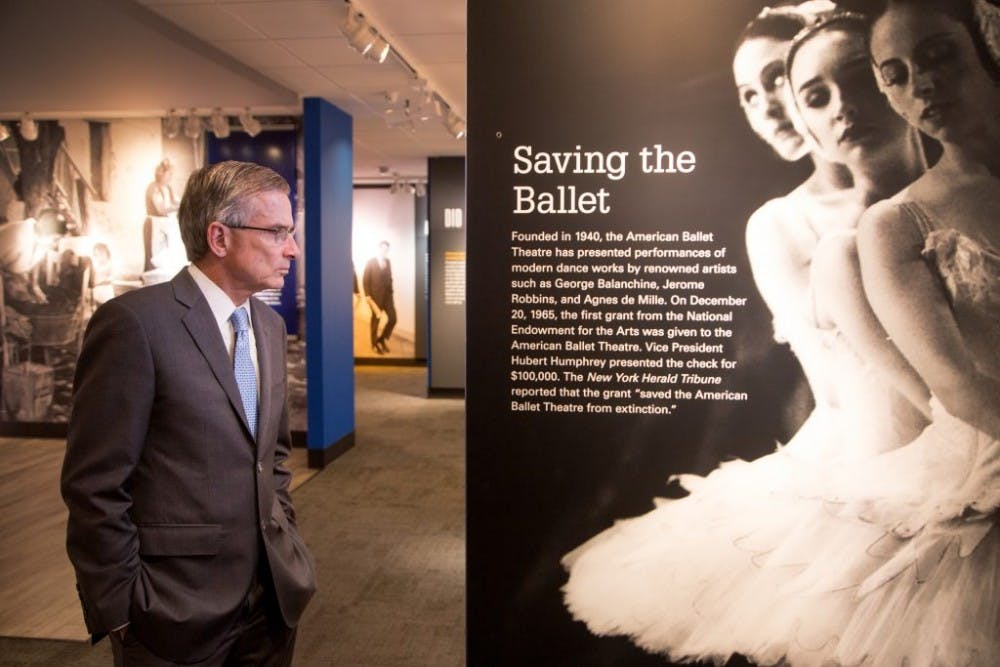Morgan: This week, we’re going to talk about the potential defunding of arts programs and the status of art in the Trump era. There has been speculation that Trump may eliminate the National Endowment for the Arts (NEA) and the National Endowment for the Humanities (NEH), both agencies that have been around for over 50 years.
Audrey: To understand what the end of these institutions might mean, let’s take a look back at their beginning. In 1965, at the founding ceremony of the NEA and NEH, Senator Claiborne Pell described the event as “the first time in our history [that] a president of the United States has given his administration support to such a comprehensive measure which combines the two areas most significant to our nation’s cultural advancement and to the full growth of a truly great society.”
Morgan: Fifty years ago, the president understood the value of art. I’m not sure if that is still true today. I also wonder, how does Trump intend to make America great again by devaluing our country’s art and culture?
Audrey: Many believe that Trump should defund arts programs, but it’s important to recognize that the NEA and NEH do not support merely esoteric, high-brow endeavors in the shadowy corners of fine arts museums across the nation. In fact, 40 percent of NEA-supported activities take place in high-poverty neighborhoods, and 33 percent of NEA grants serve low-income audiences.
Morgan: That’s a good point. NEA grants give organizations and individuals the means to bring art into their communities in relevant ways. Take, for example, the CS Mobile Unit, a collaboration between the Bloomberg School of Public Health and the non-profit Baltimore Center Stage.
The project received a $40,000 grant from the NEA to bring professional theater productions to Baltimore-area prisons, juvenile detention centers, homeless shelters and assisted living homes. After performances, audiences will engage in discussions about the play’s issues and themes with their peers and the artists.
Audrey: See, that sounds like a really valuable project! And speaking of sharing stories, the NEH runs an initiative called NEH On the Road that brings small-scale versions of its large-scale exhibitions to smaller-scale museums, libraries and schools throughout the country.
On the Road showcases have recently included installations like Wild Land: Thomas Cole and American Landscape Painting and Bandits & Heroes and Poets & Saints: Popular Art of the Northeast of Brazil. A venue can submit a request to the NEH to bring an exhibition to the community for the minimal fee of $1,000. The rest of the cost is covered by the NEH with the Mid-America Arts Alliance assisting with the logistics, publicity and maintenance.
NEH On the Road, developed in 2003, highlights the importance of bringing quality humanities programming to states, towns and populations that would not otherwise have access to it. The hosting venue also receives sample lesson plans and programming guides for each of the exhibitions.
Morgan: Honestly, I’d never heard of On the Road or the CS Mobile Unit before but that doesn’t mean they’re not impactful or important. It just means we need to make the public more aware of these important initiatives. Eliminating federal funding for the arts would make it more difficult for such initiatives to continue.
Audrey: Exactly. Furthermore, defunding these initiatives does not make logical sense. The combined funds currently allocated to the NEA, NEH and Corporation for Public Broadcasting account for less than a 10th of one percent of U.S. annual federal spending. That would hardly lead to big savings.
Morgan: Right, so the benefits to organizations, individuals and communities from arts programs far outweigh any minimal savings the federal government may gain from defunding.
Audrey: Of course, this is a debate we’ve heard before over the past few decades. For the most part, it has reached the same conclusion that we just did. So it’s a bit sad to see that the threats to the NEA and NEH are once again at hand.
Back in 1965, people celebrated the opening of these two agencies. Their creation heralded in the growth of a truly great society. So what would their closing mean, and why is it being considered at all?






